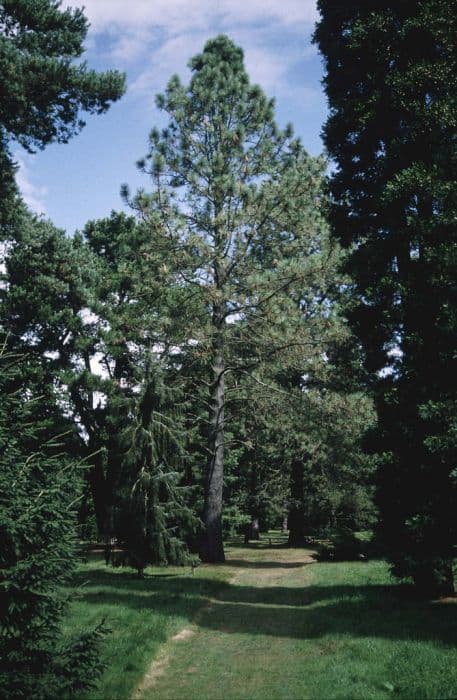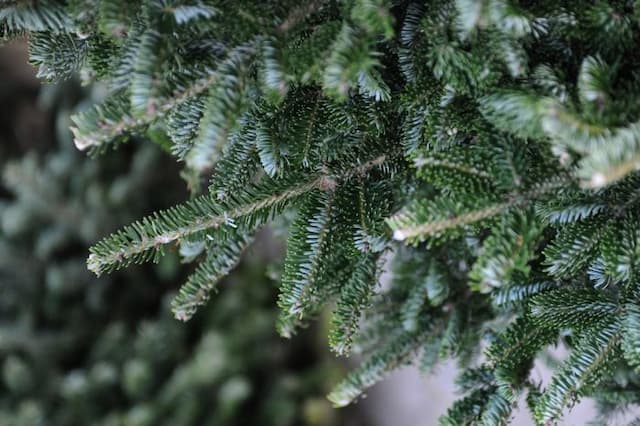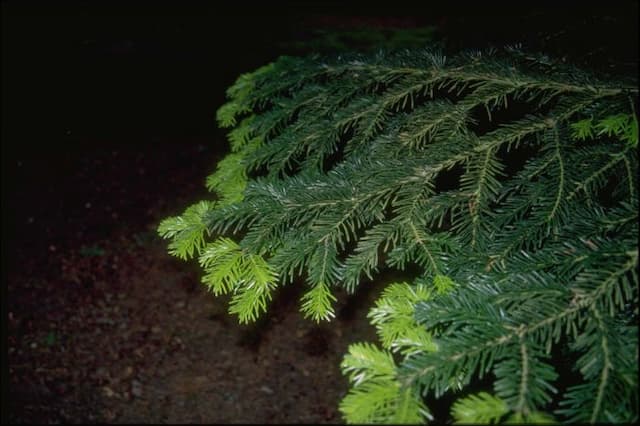Jeffrey Pine Pinus jeffreyi

ABOUT
Pinus jeffreyi, commonly known as Jeffrey pine, is an evergreen coniferous tree that is notable for its striking long needles and large, heavy cones. The needles are typically grouped in bundles of three and can differ in color, ranging from blue-green to a more yellowish-green hue. They are quite aromatic, especially when crushed, releasing a pleasant smell often compared to that of lemons or pineapple. The bark of the Jeffrey pine is thick and scaly, with a reddish-brown color which may become deeply furrowed with age. This texture gives the tree a rugged and sturdy appearance. The bark's distinctive color and pattern make it recognizable, and it is often described as smelling like vanilla or butterscotch when warmed by the sun. The cones of the Jeffrey pine are particularly large and are a distinguishing feature. They are heavy, woody, and can bear a considerable weight. The surface of these cones is covered in a prickly texture due to the presence of a hook at the end of each scale, which helps them attach to the branches until they are ready to fall. Overall, the Jeffrey pine has a majestic and robust appearance with a stout trunk and a symmetrical, conical crown when young that becomes more irregular with age. The combination of its needle color, pleasant fragrance, distinctive bark, and large cones makes the Jeffrey pine a recognizable and impressive presence in its natural habitat.
About this plant
 Names
NamesFamily
Pinaceae.
Synonyms
Jeffrey Pine, Jeffrey's Pine, Black Pine, Yellow Pine.
Common names
Apinus jeffreyi, Jeffrey Pine, Pinus deflexa, Pinus jeffreyi var. deflexa, Pinus jeffreyi var. jeffreyi.
 Toxicity
ToxicityTo humans
Jeffrey pine is generally not considered toxic to humans. There are no commonly known toxic effects from ingesting or handling this plant. However, like many plants, individual allergies can occur, and it is always advisable to exercise caution and avoid ingesting parts of ornamental or wild plants without proper knowledge.
To pets
Jeffrey pine is not typically toxic to pets. It does not contain any known toxins that would pose a risk to pets such as dogs and cats. However, consumption of non-food items can lead to gastrointestinal upset or blockages, and the oils in pine needles may cause mild irritation or allergic reactions in some pets. Care should be taken to prevent pets from ingesting large amounts of plant material.
 Characteristics
CharacteristicsLife cycle
Perennials
Foliage type
Evergreen
Color of leaves
Green
Height
70 feet (21 meters)
Spread
20 feet (6 meters)
Plant type
Tree
Hardiness zones
5
Native area
North America
Benefits
 General Benefits
General Benefits- Erosion Control: Pinus jeffreyi, commonly known as Jeffrey Pine, has a deep root system that helps stabilize soil and prevent erosion.
- Habitat Provision: This tree provides shelter and nesting sites for various wildlife species, including birds and squirrels.
- Aesthetic Value: With its tall stature and picturesque form, Jeffrey Pine is often used for ornamental purposes in landscapes and parks.
- Shade: Its dense canopy offers ample shade, which can be beneficial in reducing ground temperatures and offering a cooler environment.
- Recreational Use: Jeffrey Pines are commonly found in recreational areas, where they contribute to the natural scenery and provide space for outdoor activities.
- Wood Production: The timber from Jeffrey Pine is valuable and utilized for construction and making furniture due to its durability and pleasant scent.
- Climate Benefits: As with other trees, Jeffrey Pines play a role in carbon sequestration, helping to mitigate the effects of climate change.
- Cultural Significance: The species has cultural importance for various indigenous peoples, being used in traditional practices and as a resource.
- Wildlife Food Source: The seeds of the Jeffrey Pine are a source of food for birds, squirrels, and other forest animals.
- Forest Diversity: This species contributes to the biodiversity of forest ecosystems where it is an endemic species.
 Medical Properties
Medical Properties- This plant is not used for medical purposes.
 Air-purifying Qualities
Air-purifying QualitiesThis plant is not specifically known for air purifying qualities.
 Other Uses
Other Uses- Traditional Canoe Building: The Jeffrey pine has been used historically by Native American tribes to construct canoes due to its long, straight trunks and resilient wood.
- Woodworking Projects: Its attractive wood grain and workability make Jeffrey pine suitable for furniture making, cabinetry, and artisan woodworking.
- Fragrance Production: The bark of the Jeffrey pine exudes a sweet, vanilla-like fragrance that can be used in the production of natural scents and perfumes.
- Photography Prop: Due to its picturesque form, the Jeffrey pine is often sought after as a subject or backdrop in outdoor photography.
- Winter Sports Gear: The wood from Jeffrey pine is sometimes utilized in making snowshoes and other traditional winter sports equipment.
- Animal Habitat: Standing or fallen, Jeffrey pine trees provide shelter and habitats for various wildlife species, including birds and small mammals.
- Sap for Traditional Adhesive: The sap harvested from Jeffrey pine can be used as a natural glue or sealant in traditional crafts and tool-making.
- Historical Ink: Some Native American tribes used the soot from Jeffrey pine for making a deep black ink for tattoos and craftworks.
- Landscape Gardening: Jeffrey pine is often planted in parks and large gardens for its aesthetic appeal and as a windbreak in landscaped areas.
- Educational Tool: The tree serves as an educational specimen in many arboreta and universities for dendrology and forestry studies.
Interesting Facts
 Feng Shui
Feng ShuiJeffrey Pine is not used in Feng Shui practice.
 Zodiac Sign Compitability
Zodiac Sign CompitabilityJeffrey Pine is not used in astrology practice.
 Plant Symbolism
Plant Symbolism- Strength and Endurance: Pinus jeffreyi, commonly known as "Jeffrey pine," often grows in harsh environments, embodying resilience and the ability to withstand tough conditions.
- Longevity: The Jeffrey pine is a long-lived species, representing the idea of longevity and perseverance through time.
- Adaptability: This plant has adapted to thrive in various altitudes and types of soil, symbolizing adaptability and flexibility in life.
- Protection: The thick bark of Jeffrey pine protects it from fires, making it a symbol of protection against adversity.
- Nobility: With its tall and upright stature, the Jeffrey pine can be seen as a symbol of noble spirit and dignity.
 Water
WaterThe Jeffrey Pine should be watered deeply but infrequently to mimic its natural habitat. During the growing season, water the young trees every two to three weeks, providing 15 to 20 gallons per session, ensuring moisture reaches the deep roots. Mature trees are drought-tolerant and typically do not require additional watering once established, unless there are periods of extreme drought. In these cases, a monthly deep watering of 20 to 30 gallons may be necessary to keep the tree healthy. Adjust the amount of water depending on the soil type; sandy soils may require more frequent watering while clay soils retain moisture longer.
 Light
LightJeffrey Pines require full sunlight to thrive, meaning they need at least six hours of direct, unfiltered sunlight each day. The best spot for planting a Jeffrey Pine is an open area where it will not be shaded by other taller trees or structures. Areas with southern exposure are optimal to ensure the tree receives ample light.
 Temperature
TemperatureJeffrey Pines are adapted to thrive in a wide range of temperatures, from as low as -30°F to highs exceeding 90°F. However, their ideal temperature range for optimal growth is between 60°F and 75°F. They can endure occasional temperature extremes but consistent conditions outside the ideal range may stress the tree.
 Pruning
PruningPruning of a Jeffrey Pine is typically done to remove dead or damaged limbs, thus promoting healthy growth and reducing the risk of disease. Light pruning can be done any time of year, but major pruning should be limited to late winter or early spring before new growth starts. Prune no more than necessary, ideally not more than one-quarter of the tree's living branches in a single year.
 Cleaning
CleaningAs needed
 Soil
SoilJeffrey Pine thrives best in well-drained, sandy or loamy soil with a pH range of 5.5 to 6.5. A balanced mix of two-thirds native soil and one-third organic compost or pine bark will provide the necessary nutrients and drainage.
 Repotting
RepottingJeffrey Pines do not need frequent repotting; they can thrive in the same spot for years. Young trees may be repotted every 2-3 years to promote growth, but mature pines rarely require it.
 Humidity & Misting
Humidity & MistingJeffrey Pine prefers low to moderate humidity levels typical of its native mountainous and dry climates, and it is tolerant of dry air conditions.
 Suitable locations
Suitable locationsIndoor
Place in a bright spot, ensure good airflow, limit indoor growing due to size.
Outdoor
Plant in full sun, well-drained soil, water deeply occasionally.
Hardiness zone
5-8 USDA
 Life cycle
Life cycleJeffrey pine (Pinus jeffreyi) begins its life cycle with seed dispersal, typically by wind, animals, or gravity, with seeds originating from mature cones usually in autumn. Germination follows after the seeds come into contact with suitable soil, requiring moisture and an appropriate temperature—a process that can be triggered by fire or occur in the absence of fire. Once germinated, the seedlings grow through a juvenile phase where they develop needles, a taproot, and begin photosynthesis, becoming young saplings. As saplings, Jeffrey pines enter a rapid growth phase, characterized by vertical growth and branch development, until they reach maturity, which can last for several years. Mature Jeffrey pines produce male and female cones; male cones release pollen, which is carried to female cones by the wind for fertilization. After fertilization, the tree continues its life cycle by producing mature cones containing seeds, thereby allowing for the next generation’s dissemination, and this cycle can continue for over a century as Jeffrey pines are long-lived trees.
 Propogation
PropogationPropogation time
Spring-Early Summer
Propogation: Jeffrey pine, commonly known as Pinus jeffreyi, is often propagated by seeds as the most popular method. The best time to collect seeds for propagation is in late summer or early autumn when the cones naturally mature. The collected seeds require stratification, a process of cold treatment to break their dormancy. This involves keeping the seeds in a refrigerator at about 34-40 degrees Fahrenheit (1-4 degrees Celsius) for a period of around 60 days. After stratification, seeds are sown in well-drained soil and should be lightly covered with a layer of soil. The seeds typically germinate in the spring when temperatures become warmer, at which point they can be transplanted to their permanent growing location. Seedlings require some shelter from extreme conditions and consistent moisture until they are well-established.








